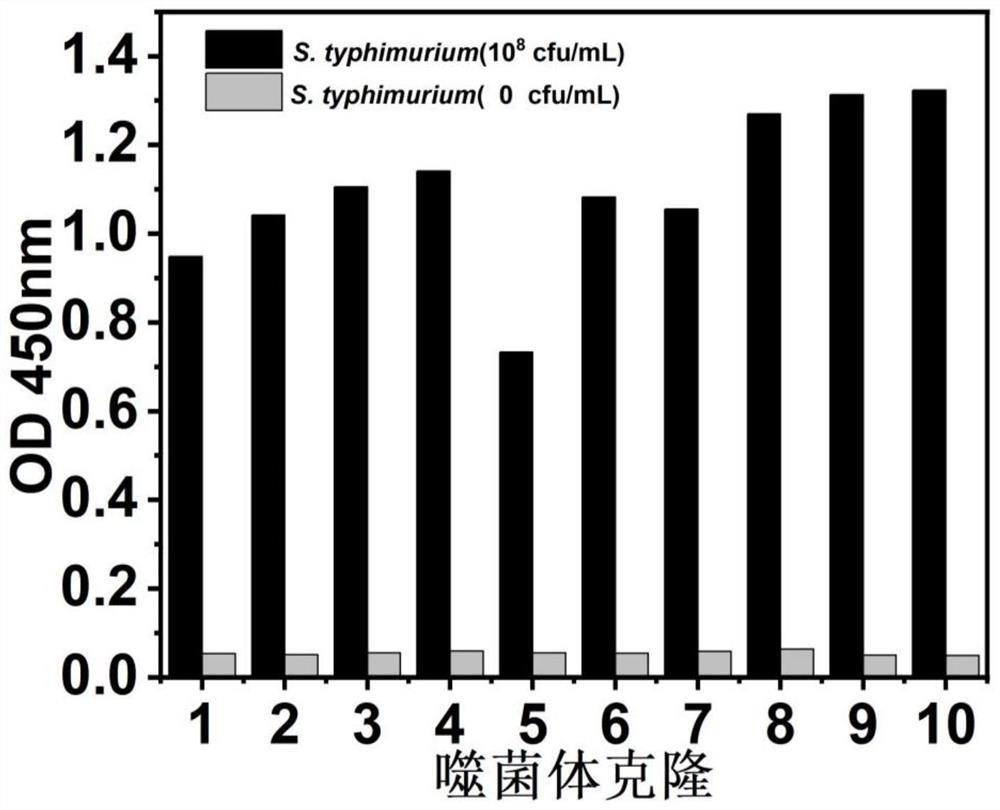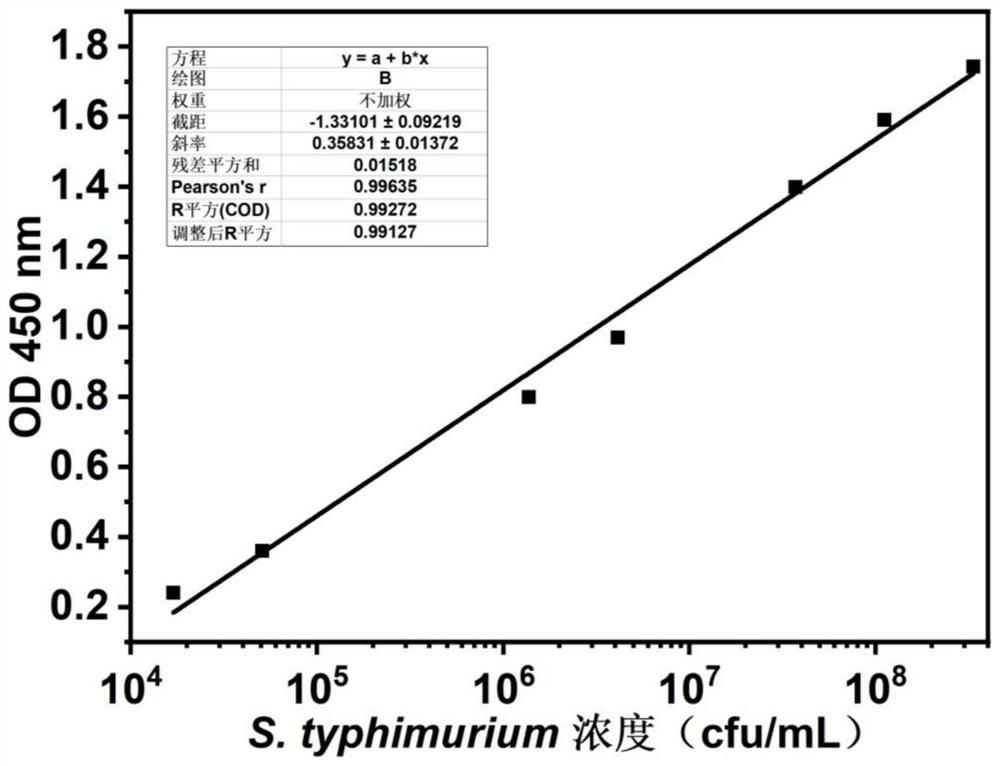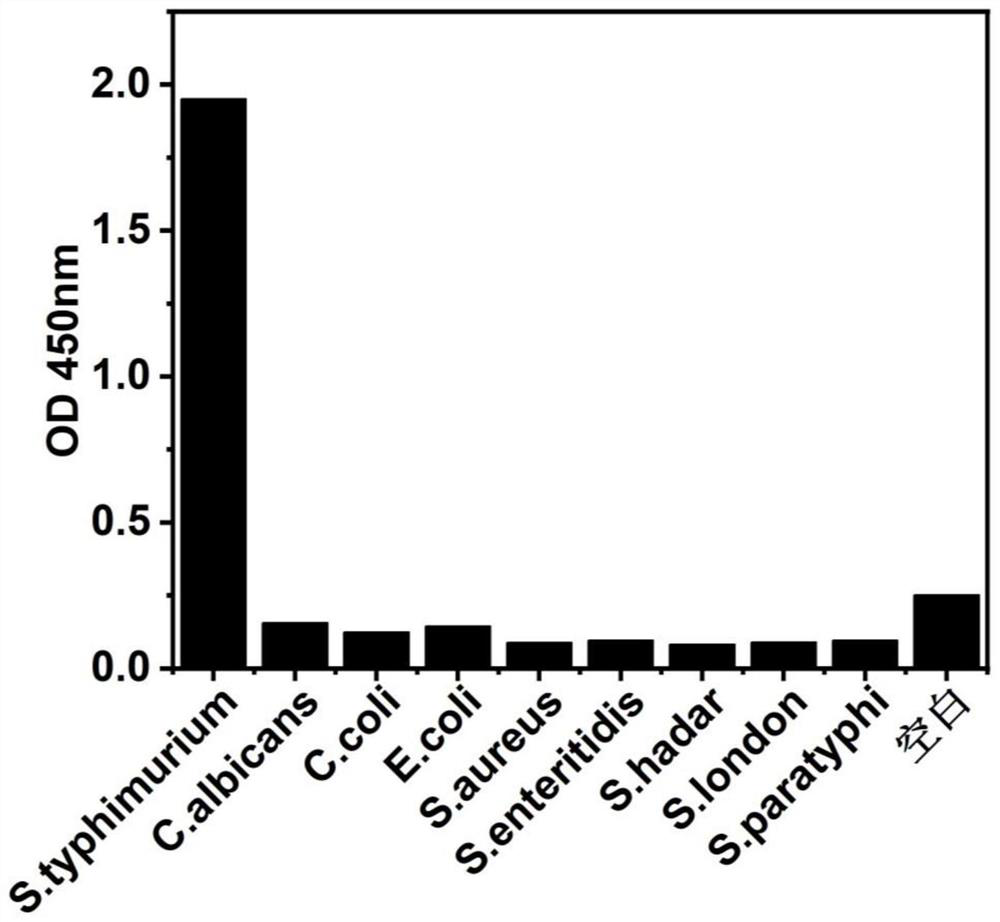Anti-salmonella typhimurium nano antibody and application thereof
A Salmonella and nano-antibody technology, applied in the field of molecular biology, can solve the problems of difficult expression, low expression efficiency, weak recognition and binding ability, etc., and achieve the effect of high affinity, strong specificity and strong stability
- Summary
- Abstract
- Description
- Claims
- Application Information
AI Technical Summary
Problems solved by technology
Method used
Image
Examples
Embodiment 1
[0033] Construction of phage display nanobody immune library
[0034] 1) Camel immunization: take 5mL and dilute to 10 8 After the CFU / mL inactivated Salmonella typhimurium liquid was emulsified with an equal volume of Freund's complete adjuvant, a healthy Bactrian camel was injected subcutaneously at multiple points, and then immunized every two weeks for a total of five times. For the second to fifth immunizations, incomplete Freund's adjuvant was used for antigen emulsification, and blood sampling began after the fourth immunization. Boost the immunization 7-10 days after the fourth immunization, and then collect 20 mL of blood from the jugular vein of the blood collection tube one week after the booster immunization. At the same time, gently invert the blood collection tube to avoid blood coagulation, and then process the blood with the filter in the LeukoLOCK RNA (Invitrogen) kit , and then rinse the filter with 3mL phosphate buffer and 3mL RNAlater buffer in sequence, t...
Embodiment 2
[0061] Example 2: Affinity panning and identification of Nanobodies
[0062] 1) Affinity panning of nanobodies: first, inactivated Salmonella typhimurium was diluted to 10 with PBS (pH 7.4). 8 CFU / mL, coated overnight at 4°C. The next day, after washing 3 times with 0.05% PBST, 3% skimmed milk powder was added to block for 1 hour at 37°C. Then wash 3 times with PBST, add 150 μL camel-derived single domain heavy chain antibody library to each well, and incubate at 37°C for 1 hour. Unbound phages were discarded, the plate was manually washed 10 times with PBST, 100 μL of Glycine-HCl (0.2 M, pH 2.2) was added to elute for 8 min, and immediately neutralized with 4 μL of Tris-HCl (1 M, pH 9.1). Take 10 μL of the eluted phage to determine the titer, and the rest is used to infect and amplify the E.coli ER2738 strain cultured to the logarithmic phase. On the third day, the amplified phage was precipitated with PEG / NaCl, and the titer of the phage was determined.
[0063] During t...
Embodiment 3
[0066] Example 3: Sequencing of Nanobody Encoding Gene and Determination of its Amino Acid Sequence
[0067] The 10 positive clones were subjected to DNA sequencing, and the DNA sequencing results were analyzed with Bioedit software to obtain an anti-Salmonella typhimurium nanobody ST-Nb9, and the framework region and complementarity determining region of the antibody sequence were determined.
[0068] The amino acid sequence of the frame region FR1 of the anti-Salmonella typhimurium nanobody ST-Nb9 is shown in SEQ NO:1;
[0069] The amino acid sequence of the framework region FR2 of the anti-Salmonella typhimurium nanobody ST-Nb9 is shown in SEQ NO:2;
[0070] The amino acid sequence of the framework region FR3 of the anti-Salmonella typhimurium nanobody ST-Nb9 is shown in SEQ NO:3;
[0071] The amino acid sequence of the frame region FR4 of the anti-Salmonella typhimurium nanobody ST-Nb9 is shown in SEQ NO:4;
[0072] The amino acid sequence of the complementarity determin...
PUM
 Login to View More
Login to View More Abstract
Description
Claims
Application Information
 Login to View More
Login to View More - R&D
- Intellectual Property
- Life Sciences
- Materials
- Tech Scout
- Unparalleled Data Quality
- Higher Quality Content
- 60% Fewer Hallucinations
Browse by: Latest US Patents, China's latest patents, Technical Efficacy Thesaurus, Application Domain, Technology Topic, Popular Technical Reports.
© 2025 PatSnap. All rights reserved.Legal|Privacy policy|Modern Slavery Act Transparency Statement|Sitemap|About US| Contact US: help@patsnap.com



